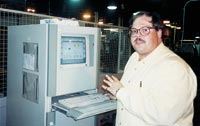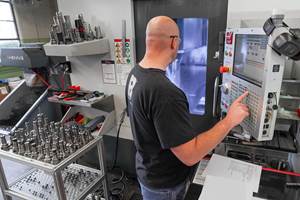Hydraulic Clamping Shows Its Staying Power
This company discovered first-hand the inconsistencies of manual clamping, where two sides of the fixture were clamped with wrenches, occasionally resulting in parts shifting on the fixtures and sometimes leading to scrap. Learn how they 'fixed' things.
Share








Autodesk, Inc.
Featured Content
View MoreTwo horizontal machining center systems have made a sudden and significant impact on production at Sta-Rite Industries (Delavan, Wisconsin). The HMCs and associated workhandling at the company’s 300,000-sq. ft. plant have reduced costs and boosted production by 30 to 40 percent since their start-up in January 1999.
The HMCs are used in the production of a broad variety of pump components for municipal, agricultural and recreational industries. Their addition at the plant is part of a three-phase $4 million capital improvement program to increase production efficiency and reduce manufacturing costs.
One issue that was a part of this program was the type of clamping used. Before embarking on this capital improvement, Sta-Rite used a manual clamping system that proved to be both time consuming and inconsistent. The inconsistencies of manual clamping, where two sides of the fixture were clamped with wrenches, occasionally resulted in parts shifting on the fixtures, sometimes leading to scrap.
A cross-matrix of manufacturing, engineering and design employees from Sta-Rite went searching for a solution by looking at a selection of equipment. The decisions on what to purchase were based on a detailed need assessment and careful evaluations of methods and machinery, following plant visits, interviews on service support and reviews of warranties. What this team found was a series of hydraulic swing clamps, accumulators, sequence valves and block cylinders from Enerpac (Milwaukee, Wisconsin), which work in tandem to speed and simplify clamping. They also provide consistent operating pressures throughout the machining process.
When the company began using the new horizontal machining centers, it put this hydraulic clamping on specially designed tombstones. This clamping has also added to the flexibility of the new HMCs and has become an integral part of the expanded operation.
With the new automated system, raw product arrives in wire baskets at a load/unload station. The specially designed tombstones travel along a RGV (Rail Guided Vehicle) and arrive at the same point. Operators release the system pressure, automatically unclamping the swing cylinders. Machined parts are manually removed, and raw parts are positioned on the face of the tombstone.
With a single finger swipe, the operator energizes the Enerpac wand system, which charges the booster and locks one face of the tombstone. When pressures reach 2,500 or 3,000 PSI, the tombstone rotates 90 degrees, and another face is unloaded and loaded.
Pleased with the early returns from the fixtures, Sta-Rite is in the process of committing to a third unit. Other additional units will be considered for future production requirements.
“The way the machining centers were set up, it doesn’t matter where the tombstone goes. It could run any of three different machines. So, if you have your machines in use, and the tombstone is loaded, it is automatically put into the next machine,” Mr. Busbey explains. This controller overseeing the RGV identifies which machines are ready for loading and unloading and prioritizes pallets for machining in the firm’s horizontal machining centers.
Even before the final phase of the expansion has been completed, the company is seeing the full impact of the automated hydraulic clamping operation.
“Just in setup alone, we no longer have the variations, the setup time and the time investment to get fixtures centered. All of this is automated,” Mr. Busbey says. “Because parts are consistently changed in the same locations, we see less product variation and less scrap over the course of a run.”
While product consistency and quality have been the primary benefits, system flexibility has been one of the primary advantages. Each one of the tombstone pallets can be detached from the tombstone for versatility.
“Sometimes, depending on the volume, we can have all four sides of a fixture running the same part. But to wrap up $40,000-50,000 in a tombstone for a product with a run of 200 pieces doesn’t add up. So, we designed it where we can plug and unplug one face and add another with a shorter run to another face. It is possible to have four different parts running on one fixture. This has presented a programming challenge, but it certainly gives us outstanding versatility,” Mr. Busbey explains.
“Although the clamping process is part of a three-shift operation, Sta-Rite has maintained production without unscheduled downtime. In a 24-hour operation you can’t afford to be down,” Mr. Busbey says. MMS
Related Content
Shop Doubles Sales with High-Mix, Low-Volume Automation
Robots with adaptive grippers have opened entire shifts of capacity to high-mix, low-volume shop Précinov, doubling its sales.
Read MoreUsing Automation to Reduce COGS and Stay Globally Competitive
Decade-long, multiphase automation investments lower operating costs and maintain technology lead in an increasingly competitive global market.
Read MoreUsing Jaws as Grippers Enables Flexible, Low-Cost Automation
VersaBuilt’s automation systems significantly boosted Innovative Fabrication’s revenue. In return, the shop has helped VersaBuilt optimize its products.
Read MoreMedical Shop Performs Lights-Out Production in Five-Axes
Moving to five-axis machining enabled this shop to dramatically reduce setup time and increase lights-out capacity, but success relied on the right combination of workholding and automation.
Read MoreRead Next
5 Rules of Thumb for Buying CNC Machine Tools
Use these tips to carefully plan your machine tool purchases and to avoid regretting your decision later.
Read MoreBuilding Out a Foundation for Student Machinists
Autodesk and Haas have teamed up to produce an introductory course for students that covers the basics of CAD, CAM and CNC while providing them with a portfolio part.
Read MoreRegistration Now Open for the Precision Machining Technology Show (PMTS) 2025
The precision machining industry’s premier event returns to Cleveland, OH, April 1-3.
Read More





































.jpg;maxWidth=300;quality=90)



.jpg;maxWidth=300;quality=90)









